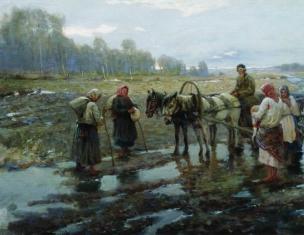Home > Wiki-textbook > Geography > 7th grade > Mineral resources of Africa: characteristics of fossils in different regions of Africa
Minerals of South Africa
The regions of Equatorial and Southern Africa contain the richest mineral deposits in the world.
Large deposits of chromite are located in Southern Rhodesia, Nigeria is rich in tungsten, and manganese reserves are located in Ghana.
The world's largest graphite deposits are located on the island of Madagascar. However, gold mining is of greatest importance to the economy of South African states.
The main gold reserves are located in the Republic of South Africa. Gold ores here were formed back in the Cambrian period.
South Africa ranks first in the world in the extraction of such minerals as copper, lead, cobalt, tungsten and tin.
Also in this region there are unique uranium ores, the content of pure uranium in which reaches 0.3%.
Minerals of North Africa
In North Africa there are deposits of such minerals as zinc, lead, cobalt, and molybdenum.
These fossils were formed in North Africa at the beginning of the Mesozoic era, during the period of active development of the African platform.
This region of the African continent is also rich in manganese. Oil-bearing sources are located in the region of Northern Sahara and Morocco.
Phosphorite-bearing zones are located between the Atlas Mountains and Libya. Phosphorites are used in the metallurgical and chemical industries, as well as in the production of agricultural fertilizers.
More than half of the world's phosphorites are mined in the North African phosphate zone.
Morocco ranks first among the countries in the world in the production of phosphorites.
Minerals of West Africa
The main wealth of the subsoil of West Africa is coal and oil.
Today, new methods of oil production in this region are being actively developed.
The main large deposits are located in the Niger Delta. West Africa is also rich in minerals such as niobium, tantalum and tin, iron ores, as well as non-ferrous ores.
The coastal regions of West Africa are home to large natural gas reservoirs.
The southern territories are rich in gold ores.
Active mining in West Africa has a beneficial effect on the development of industry in this part of the African continent. Thus, over the past decade, non-ferrous metallurgy, the chemical industry and mechanical engineering have reached a high level of development.
Need help with your studies?
Previous topic: Features of the relief of Africa: mountains and lowlands of the region
Next topic: Features of the climate of Africa: tropical and subtropical zones
Africa has a diverse range of mineral resources, many of which represent the richest deposits in the world. There are large reserves of oil, coal, ferrous and especially non-ferrous metal ores (iron, manganese, copper, zinc, tin, chromium), rare metals and uranium ores, as well as bauxite. Of the non-metallic minerals, the deposits of phosphorus and graphite are the most valuable.
Due to the fact that the ancient foundation of the platform is exposed mainly in Equatorial and Southern Africa, it is in these areas that all the most important ore deposits are concentrated. Deposits of copper in the Republic of South Africa, chromium in Southern Rhodesia, tin and tungsten in Nigeria, manganese in Ghana, and graphite on the island of Madagascar are associated with the metamorphization of the oldest Archean and Proterozoic formations.
It is known that Africa has long and steadily maintained the main place among the countries of the capitalist world in gold mining. Its main reserves are concentrated in the strata of the Proterozoic conglomerate in the Republic of South Africa (Johannesburg), and the mines are of particular value. Mineralization processes during the Cambrian period led mainly to the accumulation of polymetallic ores, as well as non-ferrous and rare metal ores.
Among the areas of Cambrian mineralization, the so-called Central African copper belt, which stretches from the Katanga region (in the southeast of Congo) through Northern and Southern Rhodesia to East Africa, stands out first of all.
The numerous deposits within this belt are mainly epigenetic, have a high metal content and provide the bulk of copper, the production of which Africa ranks second among capitalist countries. Along with copper, cobalt, lead, tin and tungsten are mined in this zone.
In Katanga, in the Kazolo-Shinkolobwe region, one of the world's most important uranium ore deposits with a very high uranium content (0.3-0.5%) is exploited. The second large area of Cambrian mineralization is concentrated in South Africa, where the formation of a number of large deposits occurred in connection with powerful outpourings of basic lavas and intrusions of granite batholis.
Complex processes of contact metamorphism culminated in the formation of large deposits of platinum ores, gold, chromium, and titanium-magnetic ores.
In addition to non-ferrous metal ores, South Africa has deposits of iron ores. Iron ores are generally of low grade; It is believed that most of them were deposited in brackish sea or ocean waters.
It is important to take into account that their accumulation, which began in the Precambrian, continued into the Silurian period. The main deposits are concentrated in the Pretoria area and in Capeland. The third area of concentration of Cambrian polymetallic ores is the Moroccan highlands of the Atlas Mountains, into which the oldest rocks of the entire mountain system are exposed.
Towards the end of the Paleozoic and the beginning of the Mesozoic era, when the African platform experienced a relatively calm tectonic stage of development and thick strata of continental sediments were deposited on its ancient axis, formations containing coal began to form. The coal basins of greatest industrial importance are in the Republic of South Africa, Northern and Southern Rhodesia, the Republic of the Congo (with its capital Leopoldville), Tanganyika and the island of Madagascar.
North of the equator, over a period of time, iron and manganese ores of sedimentary origin and oil accumulated in the continental sandstones of the Sahara. Much more favorable conditions for the formation of various minerals were established at the end of the Mesozoic era, when the sea transgressed to northern Africa from the Tethys geosyncline and faults began, leading to the isolation of the African block, accompanied by active volcanism and the intrusion of large granite batholis.
The group of areas of platform Africa includes the territory of almost the entire African platform with the exception of its eastern edge - the Abyssinian Highlands, the Somali Peninsula and the East African Plateau.
On this huge area, anteclises and syneclises of the ancient foundation alternate many times, and therefore relief forms characteristic of outcrops of the ancient foundation and areas of development of the sedimentary cover replace each other.
The largest and most delicate region in structure and relief of the Saharan-Sudanese plains and plateau occupies the northern part of the platform, from the Atlas Mountains to the North Guinean Upland and the Azande Rise
In this area, the ancient foundation protrudes three times. In the west it is exposed in the plains of crystalline peneplain Karet-Yetti (up to 500 m high), in the area of the Raghibat shield
In the center, the ancient foundation is raised in the Ahaggar and Tibesti highlands and the southern spurs of Ahaggar (Adrar-Iforas and Lir plateaus). The uplift occurred along fault lines of northwest strike.
The faults are associated with volcanism and volcanic landforms of the phonolytic peaks of Ahaggar (Mount Takhat 3005 m), basal plateaus and dry volcanoes of Tibesti (Emi-Kycсu) - 3415 m).
On the eastern edge of the Sahara, the western wing of the Eritrean crystalline arch rises above the Red Sea by the blocky Etbay ridge (the highest point is Mount El-Shayib 2184m), which abruptly ends to the coast. The areas of outcrops of crystalline rocks and their characteristic relief forms are surrounded on all sides by covers of sedimentary deposits that make up low plains and mid-altitude plateaus.
Lowlands occupy a limited area within the region. In front of the Karetietti plains lies the Atlantic accumulative marine plain; a strip of lowland also stretches along the coast of Libya and the United Arab Republic. It occupies the zone of subsidence of the edge of the African plate to the Mediterranean geosynclinal region
In the UAR, in the lowlands, there are several depressions lying below sea level (the depth of Qattara reaches -133 m), developed by exogenous processes in monoclinal structures.
In front of the Atlas Mountains lies the forward trough of the platform, which only in the east, near the Gulf of Gabes, is expressed in relief as an area of recent subsidence.
The lowest parts of the depression, vast salt marsh plains (schotts), lie below ocean level (Melgir Shott has an elevation of -30 m). Most of the pre-Atlas trough is filled with sedimentary strata, composing foothill plateaus dissected by dry valleys. The crystalline peneplain of Karet Yetti is separated from Ahaggar by the low, flat plains of El Jof and the stepped plateau of Tanezruft.
The El-Jof plains occupy most of the Aravan-Tauden syneclise, filled with Paleozoic formations; The Tanezruft plateau forms the western link of the ring of kues ridges (tassili), developed in monoclinal sedimentary rocks uplifted along the slopes of Ahaggar and Tibesti.
Comparative and comparative analysis of the liberation movement of Asian and African countries in the 20–30s: Philippines and Thailand
Comparative and comparative analysis of the liberation movement of Asian and African countries in the 20–30s: the Philippines and Thailand...
The nature of separatist tendencies in the countries of North Africa and the Middle East
Abstract: The nature of separatist tendencies in the countries of North Africa and the Middle East Arab political military separatism Four to five decades after many Arab countries gained political independence and statehood, the activity and even armed struggle of separatist movements in some of them does not stop.
Among them are various political, armed movements and groups belonging to the Christian denomination in the south of Sudan, Kurds in the north and Shiites in the south of Iraq, Berbers (Amazigh) in Algeria, Morocco, various tribes and clans in Somalia and Djibouti...
Redistribution of Africa
The relevance of this topic lies mainly in the fact that the history of the colonial division of Africa is an important part of the history of international relations in the second half of the 19th - early 20th centuries. African problems had a direct impact on the development of Anglo-Russian and Anglo-German and other relations, and on the formation of the Entente. Formation of military-political alliances at the end of the 19th century. reflected the entire spectrum of international relations and interstate conflicts, including the African region, and determined the influence of the colonial division of Africa on the foreign policy development of the colonial states.
The African vector of their foreign policy is directly related to the evolution of foreign policy in general, and also reflects the process of development of the national-state and mass consciousness of Europeans...
Colonial division of Western Equatorial Africa
Colonial division of Western Equatorial Africa Plan 1. Portuguese possession 2. Belgian possession 3. Colonial conquests in East Africa 4.
Portuguese possession 5. Division of Northeast Africa ...
Colonial division of West Africa
Colonial division of West Africa Plan Introduction 1. Portuguese expansion 2. Spanish expansion 3. Anglo-Ashanti wars 4. Yoruba countries 5. Gambia 6. French expansion ...
Africa. Physico-geographical sketch. Minerals
Africa has a diverse range of mineral resources, many of which represent the richest deposits in the world.
Deposits of ore minerals - iron, copper, zinc, tin, chromium ores, gold - are confined to the ancient foundation of the platform, composed of igneous and metamorphic rocks.
Their largest deposits are located in the south and east of Africa, where the foundation lies shallow and the ores are close to the surface. Here, in particular, there are deposits of gold and copper, the reserves of which Africa ranks first and second in the world.
Africa is famous for diamonds - the most valuable precious stones.
They are used not only as exquisite jewelry, but also as a material unsurpassed in hardness. Half of the world's diamonds are mined in Africa. Their deposits have been discovered on the southwest coast and in the center of Africa.
Deposits of non-metallic minerals - coal, oil, natural gas, phosphorites - occur in sedimentary rocks and cover the lower areas of the platform with a thick cover.
Huge oil deposits have been discovered in the northern Sahara and the coast of the Gulf of Guinea. Rich deposits of phosphorites, from which fertilizers are produced, are concentrated in the north of the continent. In sedimentary strata there are also ore minerals formed as a result of weathering of igneous and metamorphic rocks.
Thus, deposits of iron, copper, manganese ores and gold of sedimentary origin are common in western and southern Africa. The distribution of Africa's mineral resources continues to be studied.
Mineralization processes occurred mainly in the eras of ancient folding - in the Precambrian and at the beginning of the Paleozoic.
Due to the fact that the ancient foundation of the platform is exposed mainly in Equatorial and Southern Africa, it is in these areas that all the most important ore deposits are concentrated.
Deposits of copper in the Republic of South Africa, chromite in Southern Rhodesia, tin and tungsten in Nigeria, manganese in Ghana, and graphite on the island of Madagascar are associated with the metamorphization of the oldest Archean and Proterozoic formations.
However, gold is the most important among the Precambrian minerals.
Among the areas of Cambrian mineralization, the so-called Central African copper belt, which stretches from the Katanga region (in the southeast of Congo) through Northern and Southern Rhodesia to East Africa, stands out first of all. The numerous deposits within this belt are mainly epigenetic, have a high metal content and provide the bulk of copper, the production of which Africa ranks second among capitalist countries.
Along with copper, cobalt, lead, tin and tungsten are mined in this zone.
In Katanga, in the Kazolo-Shinkolobwe region, one of the world's most important uranium ore deposits with a very high uranium content (0.3-0.5%) is exploited. The second major area of Cambrian mineralization is concentrated in South Africa, where the formation of a number of large deposits occurred in connection with powerful outpourings of mafic lavas and intrusions of granitic batholiths.
Complex processes of contact metamorphism culminated in the formation of large deposits of platinum ores, gold, chromites, and titanomagnetite ores.
In addition to non-ferrous metal ores, South Africa has deposits of iron ores.
Iron ores are generally of low grade; It is believed that most of them were deposited in brackish sea or ocean waters. Their accumulation, which began in the Precambrian, continued into the Silurian period. The main deposits are concentrated in the Pretoria area and in Capeland. The third area of concentration of Cambrian polymetallic ores is the Moroccan highlands of the Atlas Mountains, into which the oldest rocks of the entire mountain system are exposed.
The mines of Morocco produce cobalt, molybdenum, zinc and lead.
Towards the end of the Paleozoic and the beginning of the Mesozoic era, when the African platform experienced a relatively calm tectonic stage of development and thick strata of continental sediments were deposited on its ancient skeleton, formations containing coals began to form. The coal basins of greatest industrial importance are in the Republic of South Africa, Northern and Southern Rhodesia, the Republic of the Congo (with its capital Leopoldville), Tanganyika and the island of Madagascar.
North of the equator, during this period of time, iron and manganese ores of sedimentary origin and oil accumulated in the continental sandstones of the Sahara.
Significantly more favorable conditions for the formation of various minerals were established at the end of the Mesozoic era, when the sea transgressed to northern Africa from the Tethys geosyncline area and faults began, leading to the isolation of the African block, accompanied by active volcanism and the intrusion of large granite batholiths.
Minerals of Africa - types, characteristics, structure
Due to the enormous size of the ancient central core, the African continent has a much smaller percentage of areas with extensive sedimentary formations of interest from the point of view of the presence of petroleum than any other continent. The only exception in this regard in interior Africa is part of western Uganda, on the border with the Congo. Here, in the vast graben of Lake Alberta, which is a limited fault depression filled with Tertiary sediments, there are oil outcrops among the development of much older crystalline rocks.
The remaining areas with any prospects are located mainly on the coastal plains bordering the continent.

In North Africa, to the west of Egypt, there is an extensive belt of sedimentary deposits stretching over 3,200 km.
Only the first exploratory studies have been carried out in Libya. In Tunisia, Algeria and Morocco, under the auspices of the French government, exploration work is underway near oil seeps. Drilling is already underway here.
Three small fields producing small amounts of oil are being developed in Algeria. Oil comes from tertiary sediments. Four fields were discovered in Morocco, the total production of which in 1946 was about 100 barrels per day. The age of oil-bearing sand rocks ranges from Jurassic to Tertiary.
Promising oil production areas in Africa
Along the west coast of Africa, south of Morocco, there are six areas that could benefit from exploration.
They are located intermittently along the coast over a considerable distance: from French West Africa to Angola.
Minerals of Africa: distribution and main deposits
Oil accumulations here are possible mainly in Cretaceous and Tertiary deposits. In Nigeria, where promising areas for the development of sedimentary formations extend far into the continent, exploratory drilling was carried out in Equatorial Africa and Angola, but the work did not yield positive results.
The vast Karoo basin in the Union of South Africa, in the south of the continent, is filled with thick strata of freshwater sediments of Gondwanan formations (age from Permian-Carboniferous to Triassic).
Exploratory drilling for oil, carried out in part by the government of the Union of South Africa, did not produce positive results, so from the point of view of the presence of industrial accumulations of oil, this area should be considered unpromising.
Although the presence of oil has not been discovered in the Gondwana formations, there are thick coal-bearing strata and accompanying deposits of bituminous shale, from which oil is obtained by distillation.
These shales are currently being mined on a small scale in Ermelo, located approximately 130 km southeast of Johannesburg. Similar deposits are found in the Gondwana formations in the Congo.
As a result of exploration work on the east coast of Africa, two areas promising for oil were identified, associated mainly with Mesozoic and Tertiary sediments.
The first region covers most of Southern Mozambique, and the second covers parts of Tangayinka, Kenya, Ethiopia, former Italian Somalia and British Somalia. Although commercial oil has not been discovered in any of these vast basins, US companies are currently searching intensively in Mozambique and Ethiopia. There are also some opportunities for oil in Eritrea, located further north on the Red Sea coast.
In the west of Madagascar, sedimentary strata ranging in age from Permian to Tertiary are developed.
The presence of tar sands and oil outcrops draws attention to this area as promising for oil. Shallow drilling, carried out intermittently by the government for many years, did not, however, produce any significant results.
Africa has a large amount of mineral resources. Of particular importance are the resources for various branches of metallurgy, which are provided by different African countries.
Deposits in the south
The southern part of the continent contains a huge number of different ores. Chromites, tungsten, and manganese are mined here. A large-scale graphite deposit was discovered on the island of Madagascar.
The extraction of precious metals such as gold is of great importance for African countries. It is mined in South Africa. In addition, South Africa contains large quantities of lead, uranium ores, tin, cobalt and copper. In the north, zinc, molybdenum, lead and manganese are mined.
Mining in the north and west
In the north of the continent there are oil fields. Morocco is considered its main producer. In the area of the Atlas mountain range near Libya there is a strip of phosphorites. They are valuable for the metallurgy and chemical industries. Various fertilizers for the agricultural industry are also produced from them. It should be emphasized that half of the world's phosphorite reserves are mined in Africa.
Petroleum and coal are the most valuable African minerals. Large deposits of them are located in the region of the river. Niger. A variety of iron and non-ferrous ores are mined in West Africa. There are natural gas deposits on the west coast, which are exported to various countries around the world. It is a cheap and efficient fuel used in everyday life and industry.
Types of minerals in Africa
If we group all minerals, then the group of combustibles includes coal and oil. Their deposits are located not only in South Africa, but also in Algeria, Libya, and Nigeria. Ores of ferrous and non-ferrous metals - aluminum, copper, titanium-magnesium, manganese, copper, antimony, tin - are mined in South Africa and Zambia, Cameroon and the Republic of Congo.
The most valuable metals are platinum and gold mined in South Africa. Among the precious stones there are deposits of diamonds. They are used not only in jewelry, but also in various industries due to their hardness.
The African continent is rich in various minerals. For some rocks and minerals, African countries make a significant contribution to global mineral production. The largest number of deposits of various rocks is located in the south of the mainland, namely in South Africa.
I read in many sources that Africa is the poorest continent on our planet. But, if we look at all the states in more detail, it becomes clear that the standard of living in them differs significantly. And all because of the presence of large mineral deposits in some countries.
The riches of North Africa
Throughout Africa there are many mineral resources. Different parts have their own, more developed, areas of the mining industry. For example, in the north there is oil, coal and natural gas. They are exported to many European countries.
The countries of North Africa are much richer and have a higher standard of living, as they are located on rich land. In addition to oil and coal, mining is carried out here:
- zinc;
- lead;
- cobalt;
- molybdenum

There are also large deposits of manganese in this region. North Africa is also known throughout the world for phosphorite mining. They are widely used in metallurgy, as well as in chemical plants. Phosphorites mined in North Africa account for more than half of the world's total. The leader in their production is Morocco.

Salt is also being mined in Morocco and Tunisia, both for domestic use and for export. All minerals in these territories were formed under the influence of many natural factors, including climate, flora and fauna, as well as various natural processes.
What is mined in South Africa
South African territory is rich in ores, precious stones, and non-ferrous metals. Ghana has large reserves of manganese, and Nigeria mines tungsten. And on the island of Madagascar there are the largest graphite deposits in the world.

But gold mining plays a more important role for the economic development of southern African countries. The country of gold on the continent is considered to be the Republic of South Africa (RSA). Many other minerals are also mined in the south, for which the continent ranks first in the list of all countries (copper, lead, etc.). But the majority of all mining enterprises belong to foreigners.
As you know, Africa has many natural resources. African states occupy high places in the ranking of global exports of raw materials for non-ferrous and ferrous metallurgy. It is no secret that South Africa is the richest in mineral resources in Africa.
Minerals of South Africa
All the most important mineral deposits are concentrated in the regions of Equatorial and Southern Africa. Nigeria is rich in tungsten, large natural mineral aggregates (chromites) can be found in Southern Rhodesia, and Ghana has large reserves of manganese.
The main gold reserves are located in the Republic of South Africa. Natural mineral formations containing gold were formed in this region back in the Cambrian period.
A large-scale graphite deposit was discovered on the island of Madagascar, but this is not as profitable for the economy as the extraction of national gold.
South Africa ranks first in the world in the extraction of minerals such as cobalt, copper, lead, tin and tungsten. In addition, this territory contains rare uranium ores, in which the pure uranium content is 0.3%.

Minerals of West Africa
West Africa is the main producer of oil and coal. Today, states are actively developing new methods for oil production in this region.
The main large deposits are located in the Niger Delta. In West Africa you can also find such minerals as: non-ferrous metal ores, iron ores, tantalum, niobium and tin ores.
Large natural gas reservoirs are found in the coastal regions of West Africa.
The extraction of such minerals in the West African region has a positive impact on the development of industry in the country. This is how the chemical industry, non-ferrous metallurgy and mechanical engineering are actively developing.
Minerals of North Africa
In the north of the continent there are main oil producers - Morocco and Northern Sahara.

There are also large sources of manganese in North Africa. There are deposits of such minerals as lead, molybdenum, zinc, and cobalt. These fossils were formed back in the Mesozoic era.
In the area of the Atlas Mountains near Libya there is a unique strip of phosphorites. They are quite useful and valuable for the chemical industry and metallurgy. Morocco ranks first in phosphorite mining among all countries in the world.
Main types of minerals in Africa
Platinum and gold are the most valuable metals mined in South Africa. The country also mines precious stones such as diamonds. They are often used in jewelry or industry due to the durability of the stones.
Africa is home to such mineral resources as oil and coal, deposits of which are located in Algeria, South Africa, Nigeria, and Libya. Ores of ferrous and non-ferrous metals - copper, aluminum, manganese, titanium-magnesium, antimony, tin - are mined in Zambia and South Africa, the Republic of Congo and Cameroon.

Minerals of Africa - video







